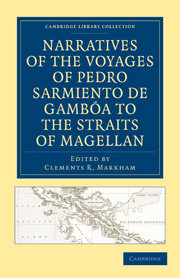Book contents
- Frontmatter
- Contents
- INTRODUCTION
- VOYAGE TO THE STRAIT OF MAGELLAN BY THE CAPTAIN PEDRO SARMIENTO DE GAMBÓA, IN THE YEARS 1579 AND 1580, AND ACCOUNTS OF THE EXPEDITION
- I NARRATIVE AND ROUTE OF THE VOYAGE AND DISCOVERY OF THE STRAIT OF THE MOTHER OF GOD, FORMERLY CALLED “OF MAGELLAN”
- 1 Causes for sending the Expedition
- 2 The Voyage from Callao to the Gulf of Trinidad
- 3 Arrival in the Gulf of Trinidad
- 4 Narrative of the first Expedition of Discovery made by the General, with the Pilots Anton Pablos and Hernando Lamero, in the boat Nuestra Señora de Guia, up the Gulf of the Most Holy Trinity.
- 5 Second Voyage of Discovery in the boat Santiago
- 6 Third Voyage of Discovery, in the boat Nuestra Señora de Guia
- 7 Voyage to the Strait of Magellan—Desertion of the Almiranta
- 8 In the Strait of Magellan
- 9 The Voyage to Spain
- 10 Letter from the Viceroy of Peru, Don Francisco de Toledo, to the Governor of Rio de la Plata
- II RELATION OF WHAT HAPPENED TO THE ROYAL FLEET FOR THE STRAIT OF MAGELLAN
- III REPORT TOUCHING THE CAPTAINS AND SHIPS, MASTERS AND PILOTS
- IV CONCISE NARRATIVE BY PEDRO SARMIENTO DE GAMBÓA
- Index
- Index
- Plate section
4 - Narrative of the first Expedition of Discovery made by the General, with the Pilots Anton Pablos and Hernando Lamero, in the boat Nuestra Señora de Guia, up the Gulf of the Most Holy Trinity.
Published online by Cambridge University Press: 05 August 2011
- Frontmatter
- Contents
- INTRODUCTION
- VOYAGE TO THE STRAIT OF MAGELLAN BY THE CAPTAIN PEDRO SARMIENTO DE GAMBÓA, IN THE YEARS 1579 AND 1580, AND ACCOUNTS OF THE EXPEDITION
- I NARRATIVE AND ROUTE OF THE VOYAGE AND DISCOVERY OF THE STRAIT OF THE MOTHER OF GOD, FORMERLY CALLED “OF MAGELLAN”
- 1 Causes for sending the Expedition
- 2 The Voyage from Callao to the Gulf of Trinidad
- 3 Arrival in the Gulf of Trinidad
- 4 Narrative of the first Expedition of Discovery made by the General, with the Pilots Anton Pablos and Hernando Lamero, in the boat Nuestra Señora de Guia, up the Gulf of the Most Holy Trinity.
- 5 Second Voyage of Discovery in the boat Santiago
- 6 Third Voyage of Discovery, in the boat Nuestra Señora de Guia
- 7 Voyage to the Strait of Magellan—Desertion of the Almiranta
- 8 In the Strait of Magellan
- 9 The Voyage to Spain
- 10 Letter from the Viceroy of Peru, Don Francisco de Toledo, to the Governor of Rio de la Plata
- II RELATION OF WHAT HAPPENED TO THE ROYAL FLEET FOR THE STRAIT OF MAGELLAN
- III REPORT TOUCHING THE CAPTAINS AND SHIPS, MASTERS AND PILOTS
- IV CONCISE NARRATIVE BY PEDRO SARMIENTO DE GAMBÓA
- Index
- Index
- Plate section
Summary
In the name of God our Lord, and of his mother St. Mary, our Lady, Pedro Sarmiento set out in the boat of the Almiranta, taking with him Anton Pablos, Pilot of the Capitana, and Hernando Lamero, Chief Pilot of the Almiranta, besides ten armed soldiers with arquebuses, shields, and swords, and provisions for four days. He left the port of “Nuestra Sefiora del Rosario” on Wednesday, the 25th of November 1579, at ten o'clock, to discover the channels, so as not to put the ships in danger, to find a safe harbour for them, and to discover the strait.
Leaving the reefs of the port of Rosario, we kept on the right-hand side in passing up the gulf, which may be described as follows. From the port of Rosario there is a point, which we called “Candelaria”, three-quarters of a league bearing a little north of east, and at half the distance there is a bay which enters into the land in a south-easterly direction. At the entrance there are twenty-three islets, which make two large channels, and although there are others, they are of no importance. From the point of “Candelaria” the coast turns a little south of east for about 500 paces, and at the cape a large port is formed, with the entrance facing north. Here there are twenty fathoms, with a clean bottom, and the port turns to the S.W. quarter.
- Type
- Chapter
- Information
- Publisher: Cambridge University PressPrint publication year: 2010First published in: 1895



